Three years ago on November 4, I finished running across the United States. By happy coincidence, I’m in Manhattan again this coming weekend, about 4 miles from the steps of City Hall, where I stopped in 2008. Like tens of thousands of other runners, I’ll be at the Jacob Javits Convention Center, attending the New York City Marathon expo. The synchronicity of dates and places was completely unplanned, but we’ve decided to turn it into a chance to celebrate and remember this anniversary.
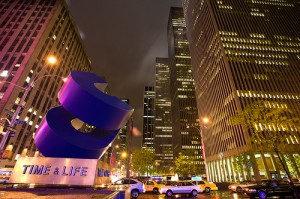 New York holds significance for me in so many ways. Not only did we finish here, but this city was also home to one of my mentors and key inspirations for the transcon, the father of modern ultrarunning, Ted Corbitt. Frank Giannino, the world-record holder who cheered me all the way, lives here. And the woman I refer to only as my “muse,” because she prefers to remain anonymous, also makes New York her home base, though she travels the world to train elite athletes.
New York holds significance for me in so many ways. Not only did we finish here, but this city was also home to one of my mentors and key inspirations for the transcon, the father of modern ultrarunning, Ted Corbitt. Frank Giannino, the world-record holder who cheered me all the way, lives here. And the woman I refer to only as my “muse,” because she prefers to remain anonymous, also makes New York her home base, though she travels the world to train elite athletes.
Since I’m in a reflective mood, I thought I’d share something I wrote about the transcon for Marathon & Beyond earlier this year, an abbreviated travelog recounting some of the people and places that stood out to me along the way. It’s a slightly different take than you get from reading Running on Empty because it focuses on and telescopes the tale of the American landscape.
Thanks for remembering with me.
The good, the bad, and the beautiful: America up close
At the starting line, another runner and I laced up together at the San Francisco Civic Center. Just over 52 days later, I finished alone on the steps of City Hall in New York, ending on Election Day, November 4, 2008. Lots of people were out, watching and cheering the returns on the jumbo screens in Times Square, and I indulged myself in pretending that the crowd and fanfare were all for me.
My crew and I had covered 3,063 miles, bisecting the United States with our slightly northeasterly route. We’d averaged more than 58 miles a day, completing the equivalent of two marathons and a 10K each day, 117 marathon distances overall. At the finish on that fall evening, the masters’ and grand masters’ records fell: I’d clocked the third fastest time in history for a trans-American crossing on foot. What’s more, the country had just elected its first African American president.
As ornery as the 2008 campaigning had been, I confess I had paid almost no attention to it or the economic tailspin going on then, too. We’d had our own ups and downs, which felt much more important to me at the time. Along the way, I’d nearly been killed twice and sustained serious injuries to my legs and feet. The other runner didn’t complete the crossing as planned because of his own injuries, and his disappointment had festered into an emotional blister on my footrace. Occasionally, tempers had flared.
It got ugly out there, both with the personal drama and the unrelenting pounding my 57-year-old body took over the miles.
Yet there were moments of wonder and humor and inspiration, of remembering and imagining. Seeing this country on foot is unlike anything else. You know how it goes: as you run, you see details, distract yourself with the magnificence or weirdness of what’s around you, maybe get a soundtrack going with your mp3 player—and then you shift your focus as you move on. I ran in a kind of bubble, seeing only what was ahead of me, my next mile, my next meal, my next chance to reconnect with my wife, Heather, for a few minutes.
The events and environment of the run took over my life for a while. And in retrospect, I’ve realized that the rich landscapes of America—the blazing, dry desert; the seemingly endless Midwestern cornfields and the rains that drenched them; and the rolling hills in the east—hold a story, too. And that story outlasts any single election cycle, any particular era, and certainly anyone who has the brief privilege to behold it.
Encountering the West–extremely up close
[flickr id=”4885168227″ thumbnail=”small” overlay=”true” size=”small” group=”” align=”right”]The history of the places we went through would wash over me sometimes, especially in the early days of the transcon. California, Nevada, Utah, and Colorado had me thinking about the pioneers who’d pushed west in the mid-1800s. I marveled at how hardy these folks had been, at their ability to deal with the conditions I ran through: intense daytime temperatures, up into the high nineties; dry air and dust that swirls up and gets caught in your nose and mouth; long stretches of desert with no signs of wildlife, just a shade tree every now and again, where you can find a minute’s relief from the sun.
In Nevada, I began heading due east on Highway 50, dubbed “America’s loneliest road” with good reason. It’s a desolate path that can make you feel desperate if you don’t take care to think about something else.
At night, though, it’s different.
The aching aloneness during the heat of day yields to the coolness of dark, hung with an uninterrupted expanse of stars. Pinpoints of brightness punch through the blanket of black with a kind of brilliance you don’t see anywhere else. The desert has a dry, earthy smell to it, musky. You can’t see much by starlight, and it’s dead quiet, so the atmosphere can put you into a meditative mood.
I remember thinking, It’s just me and the road. I felt safe, protected, and secure in the pocket of light produced by my headlamp. The scorching self-doubts and feelings of futility that haunted me in daytime took on a different feel after dark: Sure, I’m small in the grand scheme of things … but just look at how grand that scheme is!
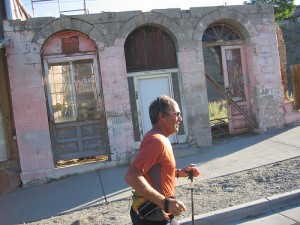 About a week after the start, we hit Austin, an old-west town plunked down smack in the middle of Nevada, where we found some of the past still standing. Flat-fronted broad buildings remind you of old-timey saloons, complete with swinging doors. (You can practically hear the clank of gunslingers’ spurs.) High-steepled churches poke the sky, just as they have since the place was settled in the 1860s. A faded brick stagecoach stop makes it easy to imagine the horse-drawn vehicles rolling up in front on giant wheels, ladies with billowing skirts and dirt-smudged faces emerging from the iconic contraptions. The town helped me escape into a fantasy world of Pony Express riders, gold prospectors, and silver miners.
About a week after the start, we hit Austin, an old-west town plunked down smack in the middle of Nevada, where we found some of the past still standing. Flat-fronted broad buildings remind you of old-timey saloons, complete with swinging doors. (You can practically hear the clank of gunslingers’ spurs.) High-steepled churches poke the sky, just as they have since the place was settled in the 1860s. A faded brick stagecoach stop makes it easy to imagine the horse-drawn vehicles rolling up in front on giant wheels, ladies with billowing skirts and dirt-smudged faces emerging from the iconic contraptions. The town helped me escape into a fantasy world of Pony Express riders, gold prospectors, and silver miners.
By the time we approached Colorado, I was completely steeped in the mythos of the old west, having spent a lot of time daydreaming about it. And things were changing for me at this point—for the better. Up until then, I’d been dogged by nightmares and increasing pain, the result of putting in 70-mile days. Back in Utah, I’d had to stop running one day, after hobbling along for just 13 excruciating miles, so the race doc could diagnose and then treat me for plantar fasciitis. After that, I’d backed off the mileage some. Dropping to an average of 60 miles a day instead of 70 had made all the difference, but I was still unresolved about it. I’d accepted that 60+ miles a day might be all I could muster, but it was hard to swallow, as I’d had it in my mind that anything less than 70 miles was a failing on my part.
Strange how once a mindset has been established, it’s hard to accept less. (Was I truly the man I thought I was? How could I own up to it?)
And then, slowly, the unabated brown-ness of the desert was broken as I ran up Highway 14. The aspen trees as we came into Steamboat Springs were backlit by a sunset, radiating hues of yellow, orange, and red through the fall leaves. My soul was drenched in the warmth of this colorful welcome home.
We weren’t far from where I’d been born, and we were gaining altitude as we climbed the Rocky Mountains, which felt like the door to our house was thrown open. My wife, Heather, and I live just above 10,000 feet in Idaho Springs, and it’s where I do most of my training. We had returned to my roots, both past and present, my home place.
Plus there was comic relief. We came across our fair share of characters through this part of the country: The old cowboy in the Colorado high country, bouncing along on his ATV to get to his mailbox, rubber bands holding his glasses on, a typical rancher who uses what’s handy to mend whatever needs fixing. The fellow from Thornton I met along the side of the road, telling me to “Hold on—I’ve got a treat for you,” who promptly dumped a jug of ice cold water over my head. Then there were another couple of guys near Cameron Pass, who spat chew out the windows of their white pick-up, half of it landing on the doors, as they assured me they would never run as far as I was—unless a woman was chasing them.
“It’s easier to drive across the country.” They tried to make their faces look serious for a moment.
Then they chuckled together, waved goodbye, and pulled off in a cloud of dust.
Awed by the expanse of Middle America
We left family and friends in Colorado—including all three of my grown children, who’d come out to crew for me there—to cross into the Midwest, my wife’s old stomping grounds. (Heather was born and raised in Minnesota.) From Eastern Colorado to Pennsylvania, the land was memorable mostly for the thousands of miles of corn and the roads cutting a straight line between the fields. Rows to the right and left of me, big sky overhead.
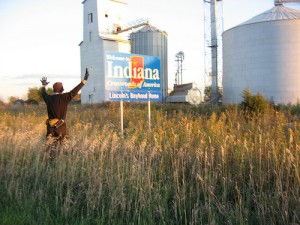 Starting in Nebraska and all through the “I” states (Iowa, Illinois, Indiana) and on into Ohio, that sky often dampened my spirits—literally—dumping rain on us. But even in my sodden state, I had to marvel at the sprawling magnitude of this king crop. I found out later that 80 million U.S. acres produce corn, the majority of it in the Heartland. Day after day for about three weeks, I ran past the tall stalks. They provided a privacy screen for roadside bathroom breaks, but by the time we got to Ohio, I was tired and brazen enough to remark to a newspaper reporter that one of the things I was most looking forward to after we reached New York was being able to stop crapping in cornfields.
Starting in Nebraska and all through the “I” states (Iowa, Illinois, Indiana) and on into Ohio, that sky often dampened my spirits—literally—dumping rain on us. But even in my sodden state, I had to marvel at the sprawling magnitude of this king crop. I found out later that 80 million U.S. acres produce corn, the majority of it in the Heartland. Day after day for about three weeks, I ran past the tall stalks. They provided a privacy screen for roadside bathroom breaks, but by the time we got to Ohio, I was tired and brazen enough to remark to a newspaper reporter that one of the things I was most looking forward to after we reached New York was being able to stop crapping in cornfields.
Delicate, I’m not. And the transcon didn’t exactly refine my sensibilities.
That’s not to say I didn’t have transcendent experiences or find poetry in the run. Those desert nights had moved me. I’d been uplifted by people who joined in to go with me for a few miles or longer, especially when kids would come out to cheer and chatter and jog alongside me.
And even in the midst of all that corn, there were strange and wonderful things to see, like the giant ethanol plants that convert corn to fuel. From a distance at night, they looked like space stations with shiny metallic surfaces and bright lights. As you get closer, they resemble a bunch of outsized aluminum cans stacked up and connected with intricate piping. They’re just plain strange, seemingly out of place in the middle of thousands of acres of farmland, alien and enormous.
Finding liberty in the East
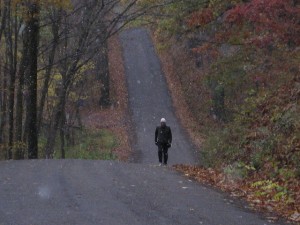 Coming into Pennsylvania, I found that the landscape shifted dramatically, crop fields yielding to rolling hills. Because I’d been on the flat in Illinois and Indiana,the elevation changes were challenging: it felt as if the muscles I needed now had atrophied some. I’m not sure if that’s really true, or if the fatigue of 45 days on the run was just catching up to me. It was also cold, with temps dropping into the low thirties and snow falling as we left Ohio and crossed into Pennsylvania. I started running in long underwear instead of short sleeves and shorts, a wardrobe reminiscent of what one colorful fellow had worn during a transcontinental race across the United States decades before, the 1928 Bunion Derby,
Coming into Pennsylvania, I found that the landscape shifted dramatically, crop fields yielding to rolling hills. Because I’d been on the flat in Illinois and Indiana,the elevation changes were challenging: it felt as if the muscles I needed now had atrophied some. I’m not sure if that’s really true, or if the fatigue of 45 days on the run was just catching up to me. It was also cold, with temps dropping into the low thirties and snow falling as we left Ohio and crossed into Pennsylvania. I started running in long underwear instead of short sleeves and shorts, a wardrobe reminiscent of what one colorful fellow had worn during a transcontinental race across the United States decades before, the 1928 Bunion Derby,
The entire run had been a series of contrasts: from the desert heat to the icy northeast … from the historic bridges and landmarks to the modern industrial machinery … from the barren stretch of America’s loneliest road to the bustling areas like the town of State College, where Penn State is located … from the farmers in rural areas to the mean streets of urban neighborhoods. These places held the unexpected, too, like the couple of times I encountered law enforcement, often in friendly circumstances but on a few occasions that weren’t, or the inhospitable farmer who shot at me in the middle of the night near Sandusky, or the surprising nonchalance I felt as I ran through a seedy part of New Jersey.
Running across the United States—or maybe doing any extreme endurance effort—alters your perception of “safety.” Was I more protected running along the heavily trafficked roads, where a truck could have nailed me (and where I got sandwiched between two cars travelling about 60 mph one night), or jogging through a gang neighborhood, where I guessed I could probably outrun anyone who thought to start trouble?
I was never invincible, although I sometimes had to think I was. When it comes down to it, I’m as vulnerable as the next guy, right? So what: I can run 60 miles a day, and maybe if someone was chasing me with a crow bar, I might be able to rise to the occasion (or run away from it). Unless the chase started out slow and went for at least 10K, a thug has more fast-twitch muscles than I do, and I’d probably be road kill of a different flavor. And sure, a car could have hit me. It wasn’t just that one time when I got caught between two vehicles; more than once, a member of my crew pulled me out of harm’s way, grabbing me by the shirt and yanking me out of traffic like a two-year-old. Or I could have gotten bit by the rattlesnake I’d teased with a stick. Or that farmer could have had better aim.
Any of those things could have happened, and then you wouldn’t be reading this right now.
But I can’t sit around and think about that, or I’d wind up doing something just as dangerous: killing time, done with daring.
No, that’s not how I choose to live.
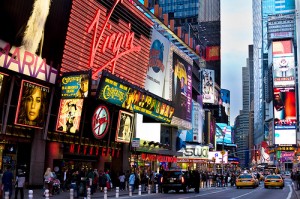 If I did, I never would have seen the finish, coming into New York City, running straight down Broadway and into Times Square. After thousands of miles, my body was beaten, but I was feeling no pain. The elation took over as I looked up at Manhattan’s skyscrapers and waved at the crowds in the streets, the usual crazy hustle of NYC ratcheted up even higher because of the elections concluding that night. I shared a cigar with a guy in an Escalade, who handed it to me for a puff while we stopped at a traffic light. The whole scene was surreal.
If I did, I never would have seen the finish, coming into New York City, running straight down Broadway and into Times Square. After thousands of miles, my body was beaten, but I was feeling no pain. The elation took over as I looked up at Manhattan’s skyscrapers and waved at the crowds in the streets, the usual crazy hustle of NYC ratcheted up even higher because of the elections concluding that night. I shared a cigar with a guy in an Escalade, who handed it to me for a puff while we stopped at a traffic light. The whole scene was surreal.
As I got closer to New York City Hall, others fell in step beside me: Heather, two of my children, Elaine and Taylor; a couple of my closest friends, Mark Macy and Tom Triumph; Brian Weinberg, the only person other than my wife to crew the entire transcon from beginning to end; and some runners who came out to see me finish. They would go with me all the way to the bottom of the broad steps, and then it was just Heather, all three children (Ali joined us near the security gate), and me to the top.
We went up the elongated steps that run the length of the building, which is supported by huge white pillars, and lead up to an impressive entrance. It was about 7 p.m., and the area was lit, casting imposing shadows that added drama to the scene. The air was crisp and clear as I inhaled it, not the smell you might expect in a big city. The small group still at the bottom of the steps clapped and cheered.
I turned, eager to embrace my wife. My focus narrowed to her face, our emotions overwhelming us both with tears and laughter. Everything else dropped away as she kept repeating, “You did it, you did it, you did it …”
My friends and family gathered around me, and it was those who love and care about me that made these final moments so meaningful. They’d helped me finish what I’d started, always been there for me even when I thought I was running alone. Even Frank Giannino, still the trans-American world record holder, had been cheering me on across the country and was there to congratulate me at the finish. All of this encouragement and support proved to me that my perception of being on my own, utterly self-reliant, had been the hardest thing of all. That solitariness had been a painful illusion, one that I finally saw through. In that moment, I felt connected to everyone around me, both strangers and loved ones.
I jumped with my fist in the air, my final intense physical effort of this contest.
Experiencing America from the ground up
That’s why we run, isn’t it? To take it all in, see what we can learn from the
experience and how we fit into the big picture, test ourselves against what
nature can dish out and what generations before us have already proven? Running across the U.S. gave me a unique view of our country, step by step, one mile at a time. My appreciation for the land grew, the generosity and kindness of most of the people we met impressed me, the hardship chastened my spirit, and the loving support of my wife lifted me up every day that I was out there. This effort paid homage to all those who’d crossed the country on foot before. It was an extreme site-seeing trip, the tour of a lifetime. It gave tribute to those who supported me through the journey, those unsung heroes that I have no right taking for granted every day, along the way.
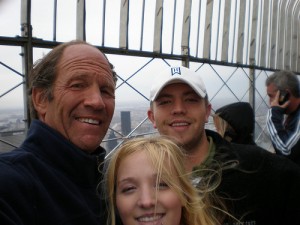 The day after my finish, the family went for a walk to see the Empire State Building. Heather, Ali, Taylor, and I walked to the landmark from the hotel, went up, snapped photos, and then about three blocks later, I gave up. My legs were tired and my feet ached. I didn’t have anything left to prove, so I sat down by a flowerbed and smiled as I took the weight off, encouraging them to go on and come back for me when they were ready. I wanted to wait there, be still, watch the passersby.
The day after my finish, the family went for a walk to see the Empire State Building. Heather, Ali, Taylor, and I walked to the landmark from the hotel, went up, snapped photos, and then about three blocks later, I gave up. My legs were tired and my feet ached. I didn’t have anything left to prove, so I sat down by a flowerbed and smiled as I took the weight off, encouraging them to go on and come back for me when they were ready. I wanted to wait there, be still, watch the passersby.
Taylor came back to get me after they were done, maybe 15 minutes later. He walked over and lifted me up off my low perch, helping me to my feet. It was one of those odd moments when time seems to bend. How often had I done that for him when he was a child?
This is what it all boils down to for me: as grandiose as this adventure may have been, the greatest fulfillment has come from something other than the achievement of this goal. It has come from the realization that I didn’t do this, or anything else, really, alone. The whole experience brought me up close with America, and with the truth of my own existence. Both left me feeling inspired and hopeful, at peace with old ghosts and prepared to face a new phase of life.
——
This article first appeared in the May/June 2011 edition of Marathon & Beyond. Subscribe to this bimonthly magazine, tailored specifically for marathoners and ultrarunners, to run longer, better, smarter.








